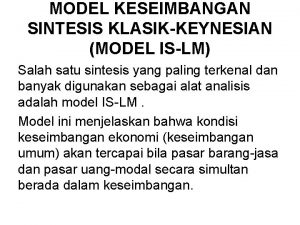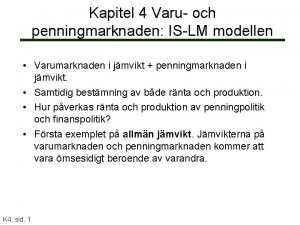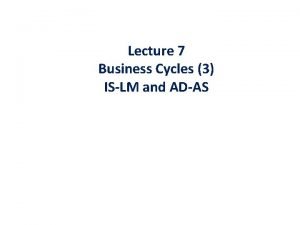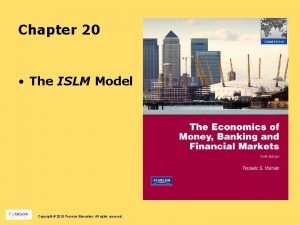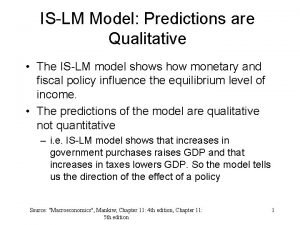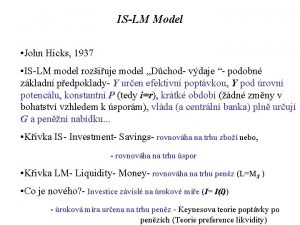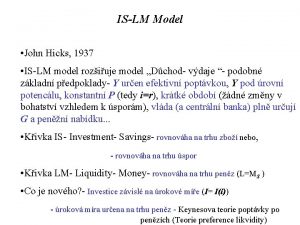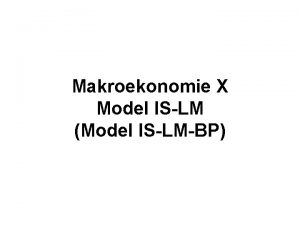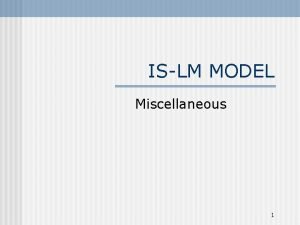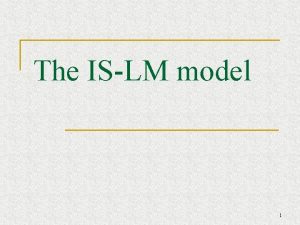Policy Analysis With the ISLM Model Policy Analysis























- Slides: 23

Policy Analysis With the IS-LM Model

Policy Analysis with the IS-LM Model A Closer Look at Policy • Fiscal Policy and Crowding Out • Monetary Policy and the Liquidity Trap Real World Monetary and Fiscal Policy Problems of Using IS-LM in the Real World • Interpretation Problems • Implementation Problems

Policy in the IS-LM Model Fiscal Policy • Expansionary fiscal policy shifts the IS curve to the right • Contractionary fiscal policy shifts the IS curve to the left Monetary Policy • Expansionary monetary policy shifts the LM curve to the right • Contractionary monetary policy shifts the LM curve to the left

Real Interest Rate (%) 1. The multiplier is 2 and government spending increases by $500, so the IS increases by $1000. Fiscal Crowding Out 2. The increase in income increases money demand which increases interest rates from 4% to 5%. LM 3. The increase in the interest rate causes a decrease in investment so that the increase in income is only $600, less that the full multiplier effect. $1000 5% 4% IS 1 IS 0 $6000 $6600 $7000 Aggregate Output

Fiscal Policy and Crowding Out When government expenditures increase, output and income begin to increase. The increase in income increases the demand for money. The increase in money demand increases the interest rate. Higher interest rates cause a decrease in investment, offsetting some of the expansionary effect of the increase in government spending.

Real Interest Rate (%) 1. The multiplier is 2 and government spending increases by $500, so the IS increases by $1000. LM 9% $1000 Full Crowding Out 2. If the demand for money is totally insensitive to the interest rate, the interest rate increases from 4% to 9%. 3. The increase in the interest rate causes a decrease in investment that completely offsets the increase in government spending. 4% IS 1 IS 0 $6000 $7000 Aggregate Output

Ineffective Fiscal Policy When complete crowding out occurs, fiscal policy is ineffective, changing only interest rates, not output. Crowding out is greater if: • Money demand is very sensitive to income changes • Money demand is not very sensitive to interest rate changes

The Fed increases the money supply which decreases interest rates and increases investment and output. LM 0 LM 1 r 0 r 1 Real Interest Rate (%) Monetary Policy and Liquidity Traps In a liquidity trap, increases in the money supply do not decrease interest rates, so investment and output do not increase. LM 0 LM 1 r 0 IS Y 0 Y 1 Aggregate Output IS Y 0 Aggregate Output

Ineffective Monetary Policy Investment is not sensitive to the interest rate • If investment does not respond to interest rate changes (the IS curve is steep), monetary policy in ineffective in changing output. Liquidity trap • If increases in the money supply fail to lower interest rates, monetary policy is ineffective in increasing output.

Other Theories

Problems Using IS-LM Interpretation Problems (what is happening? ) • Problems in knowing how to interpret real- world events within the IS-LM framework Implementation Problems (how to deal with it? ) • Problems encountered in undertaking policy

Interpretation Problems Interest Rate Problem Credit Conditions Problems Budget Problems • Cyclical and Structural Problems • Accounting Methods

The Interest Rate Problem Which interest rate, nominal or real, is relevant? Which of many interest rates in the economy is relevant? • The Federal funds rate? • The interest rate households and businesses pay to borrow money?

Why Interest Rates Differ Default risk • Interest rates differ according to the likelihood that the borrower will repay the loan. Term to Maturity • The longer the term to maturity, the higher the interest rate that is paid because Bonds with longer maturities are less liquid Differences in expected inflation More uncertainty

Inverted Yield Curve 6 6 5. 5 5 5 Yield(%) Typical Yield Curve 4. 5 4 4 3. 5 3 6 mos. 1 2 yr. 5 10 30 Maturities

Interest Rates (Sep. 2005)

Monetary Policy Tools and Credit Condition Problems The IS-LM model assumes that interest rates are the only determinant of investment. Investment may also depends on credit conditions, the willingness of banks to lend independent of interest rates. If banks raise their lending standards, investment may not respond to expansionary monetary policy. Mexico after 1994, Japan in the 90 s.

Cyclical and Structural Budgets The structural budget surplus or deficit is the fiscal budget balance that would exist when the economy is at potential output. The cyclical budget surplus or deficit is that portion of the fiscal budget balance that exists because output is above or below potential output.

Recent government budgets

Policy Implementation Problems Uncertainty about Potential Output Information Lag Policy Implementation Lag

Uncertainty About Potential Output One macroeconomic policy goal is to keep output as close to potential as possible. But, what is potential output? If policymakers use contractionary policy when the economy is actually below potential, they create ‘unnecessary’ unemployment. Using expansionary policy above potential output will cause inflation.

Information Lag The IS-LM model assumes that policymakers see what is happening in the economy and can instantly alter policies to fix any problem. In the real world there is an information lag, a delay between a change in the economy and knowledge of that change. • Example: are we in a recession or a boom right now?

Policy Implementation Lag The policy implementation lag: the delay between the time policymakers recognize the need for a policy action and when the policy is actually instituted. U. S. fiscal policy has a large implementation lag because policy must be formulated and legislation passed by Congress and signed by the President. Monetary policy has a much shorter implementation lag because the Federal Open Market Committee decides monetary policy and implements it immediately.
 Model keseimbangan keynesian
Model keseimbangan keynesian Islm modellen
Islm modellen Islm adas
Islm adas Islm
Islm Hình ảnh bộ gõ cơ thể búng tay
Hình ảnh bộ gõ cơ thể búng tay Ng-html
Ng-html Bổ thể
Bổ thể Tỉ lệ cơ thể trẻ em
Tỉ lệ cơ thể trẻ em Chó sói
Chó sói Chụp phim tư thế worms-breton
Chụp phim tư thế worms-breton Chúa sống lại
Chúa sống lại Kể tên các môn thể thao
Kể tên các môn thể thao Thế nào là hệ số cao nhất
Thế nào là hệ số cao nhất Các châu lục và đại dương trên thế giới
Các châu lục và đại dương trên thế giới Công thức tính thế năng
Công thức tính thế năng Trời xanh đây là của chúng ta thể thơ
Trời xanh đây là của chúng ta thể thơ Mật thư anh em như thể tay chân
Mật thư anh em như thể tay chân 101012 bằng
101012 bằng Phản ứng thế ankan
Phản ứng thế ankan Các châu lục và đại dương trên thế giới
Các châu lục và đại dương trên thế giới Thể thơ truyền thống
Thể thơ truyền thống Quá trình desamine hóa có thể tạo ra
Quá trình desamine hóa có thể tạo ra Một số thể thơ truyền thống
Một số thể thơ truyền thống Bàn tay mà dây bẩn
Bàn tay mà dây bẩn
